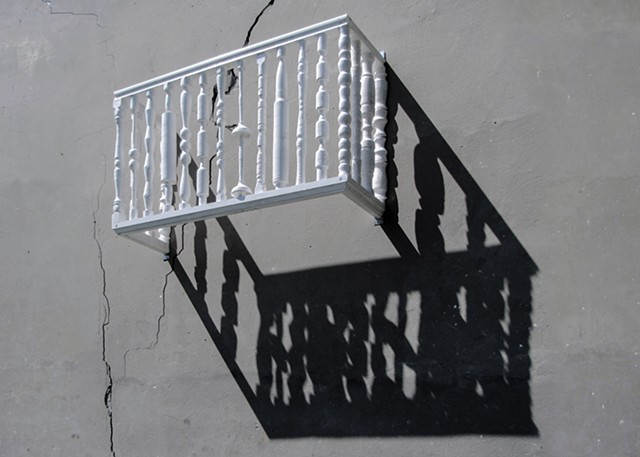Tomasz Matuszak
Tomasz Matuszak
Tomasz Matuszak graduated from the Academy of Fine Arts in Lodz, Poland. He works in the field of installation, sculpture, photography, video, and public intervention. Many of his works are based on a sustained involvement with the environment of the gallery or any given public space. By adding a specific comment to a ‘space,’ his works are integrated within it, creating a new or different meaning to the habitual perceptions. Most of the works are, therefore, site-specific and seek to energize a space (indoor or outdoor), or a social or political situation, by making these spaces a key element of the viewer’s experience.
Works:
‘Dictators Balcony,’ painted wood, 180 x 80 x 50 cm
‘Trash,’ wood, polichromy, 170 x 80 x 30 cm
‘Project for the Monument,’ wood, polichromy, 120 x 70 x 60 cm
On fictions, trompe-l'esprit and the occasional serious joke: approaching the work of Tomasz Matuszak
"Artists live a frolic life, pay nothing in"
(Anonymous)
René Magritte said that his works were trompe-l'esprit, that is: traps for the spirit in which the shock of our perception is altered by a decontextualization made ex profeso. In the case of Tomasz Matuszak's work we also find these games, these traps. Only that, in his case, not only the context is altered, but also visual deceptions are made through materials and, more: we find real semantic clashes between the works and their titles.
If the avant-garde of more than a century ago and artists like Man Ray began to work against materials to explore their creative limits, now here Matuszak's work gives us another turn of the screw. His pieces, instead of using scrap materials to create works with a different appearance, use "noble" materials to simulate non-artistic objects: an unfolded cardboard but made of wood or a supposed box wrapped in black plastic, which is really a ceramic piece. The decontextualization thus takes place in different layers, of form, of content, of semantic manipulation.
Visual deceptions -and of spirit- that also speak to us with irony about our perception of art, and of the world. A need to appear what one is not that, in his case, plays with the appearance of what one does not want to be. If art used noble materials and imitation of what was supposedly beautiful to then unseat both nobility and beauty, now Matuszak makes a game of both in which the model, despite the precision and quality of technique and material, speaks to us of waste, of destruction of a world that speaks well of what we do and what happens around us. Visual jokes, yes, but very serious.
Just as serious is the newspaper that we can read/not read -as long as we do not understand it- even if it makes us smile and laugh more than once. Art news that are impossible to understand, due to the google-derived devirtualization to which they have been subjected. But isn't the world of art and its intricate theories sometimes so complex that they border on the absurd? Manipulating language in this way is nothing more than a metaphor for that world that, so theoretical, has become hermetic, so much wanting to communicate, has ended up saying nothing, to remain in empty speeches. A joke that, well thought out, leaves a certain bitter, nihilistic taste at the end of its tasting. Who better than a conscious artist to joke with the art world itself and its mechanisms. Here he is.
In his book Science and Friction, the photographer and thinker Joan Fontcuberta warns us that "we become receiving agents of information that we consume, but do not think about. In this way, information makes us ignorant. And ignorance makes us submissive". This warning is so true that it is even hurtful, because this accumulation of information, paradoxically, makes us ignorant, unthinking, perhaps because of our inability to manage so much voluptuousness. In Matuszak's work, the artist seems to want to tell us: "observe well, realize what is and what is not. Do not judge appearances or disdain these forms. You create them yourself, your perception is wrong. As it happens every day".
In the exhibition titled Supe * market - exhibition is filled with objects, messages and contradictions. It's a kind of circle of ambivalence where nothing is what it seems.
In this so-called aesthetics of "as if it were" (but it is not), art plays with the multiple possibilities that exist between image, language and our perception. In his essay This is not a pipe, Michel Foucault tells us: "Similarity multiplies different statements, which dance together, leaning and falling on each other". This falling, leaning, dancing is precisely what Matuszak's works do, placing us in sometimes absurd, sometimes funny, sometimes uncomfortable positions. Jokes, look well, very serious, very well done.
...
It happens that there is no connection between the author and his work, and this contrast may surprise us. When it comes to Tomasz Matuszak, his sense of humor and playful gestures remind us of the games through which his creativity is manifested. However, these games are still a measure of value. This humor, analyzed, turns out to be meaningful and everlasting. And the fact is that, through jokes, we can say very serious things, and people with humor know the seriousness of what they are dealing with.
This is the case of Matuszak, an honor to have him here and to reflect thanks to his work around fictions and jokes very much to be taken into account, which speak to us of our perception -that is: our limitations- and of the infinite possibilities of winks that art has. With him, we close this first cycle of curatorships at Bacalarte Gallery.
Thanks to him, to the artists who have participated and to all those who have made it possible. No fictions, no jokes. Very seriously: thank you.
Text for Tomasz Matuszak’s “Supe*market” exhibition in Bacalarte Gallery, Warsaw, 2021. Inés R. Artola, Curator.
